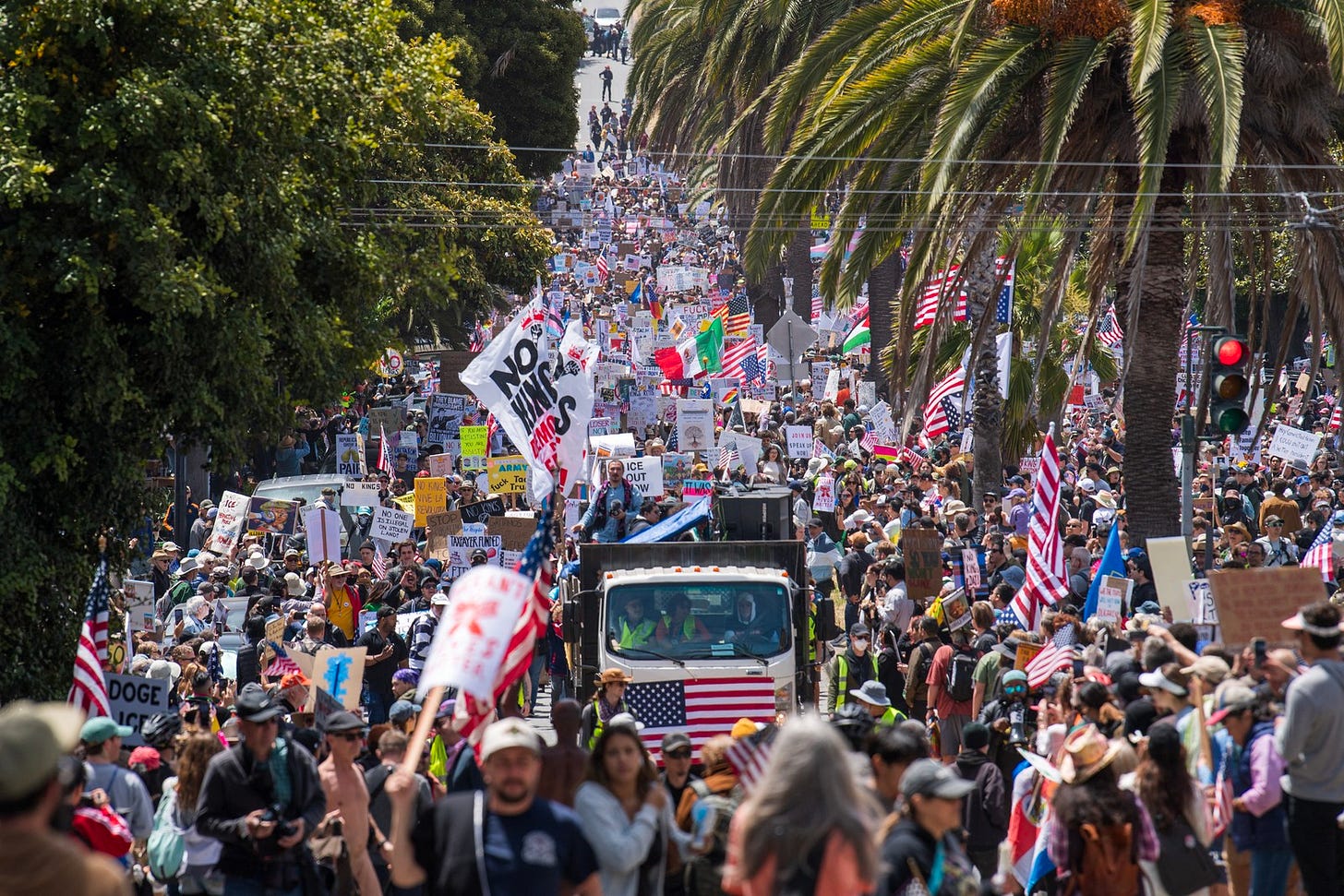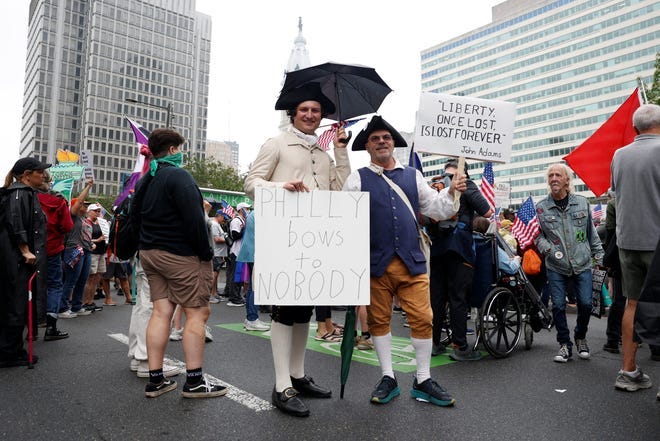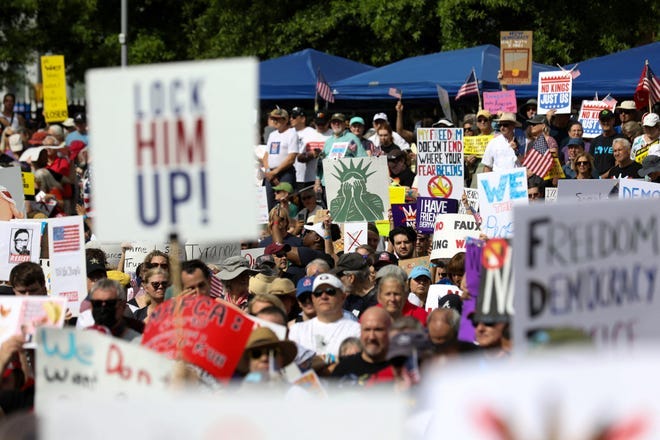No Kings Day and the Art of Refusal
Les Mis, Protest Signs, and Children Reclaiming the National Anthem: How Art Plays Into Protest.
It was the sound of hundreds singing “Do You Hear the People Sing?” from Les Misérables. It was Hamilton lyrics shouted into the air like declarations. It was soldiers stepping out of rhythm with each other — a choreographed disruption of unity. It was signs, music, silence, and joy.
No Kings Day — a protest reclaiming and defending true democracy, spotlighting the incomplete promises of freedom in a nation still ruled by inequality. And more than a political statement, it was a performance.
Because at No Kings Day 2025, protest didn’t just march — it sang, it danced, it created. And in doing so, it reminded us that art is not a luxury in movements — it’s a necessity.
Protest Is Performance
In today's political climate, it often feels hard to say that one loves the United States; but I always have.
Never the people who run it, never the laws and regulations made by and for those on top. But the dream, the absolutely cracked dream that a bunch of 20 year olds had in the 1700s and the drive for justice, for representation, for freedom — democracy. I love America, adore her, and it pains me to watch people pervert who she really is.
So when I saw a young boy playing the national anthem on a trumpet dressed with a sign that read “let freedom ring”, I lost it. When protesters reclaim the anthem, they rewrite who freedom is really for.
When Protest Becomes Art
Movements from the Civil Rights era to Stonewall to Black Lives Matter have used choreography, symbolism, song, and silence as potent tools of resistance. The reason? Because art sticks. People forget headlines. But they remember the haunting image of a solitary raised fist. The sound of a crowd singing in harmony. The clever punch of a protest sign that goes viral.
Performance is not a distraction from the “serious work” — it is the work. It reframes narratives. It brings people in. It inspires action.
🎭 “Do You Hear the People Sing?” Echoes Through the Streets
Perhaps the most talked-about moment was the collective rendition of Les Misérables’ revolutionary anthem — sung by protesters in various locations along protest routes. Not to mention, former President Trump had just attended a Broadway showing of the same show days earlier.
The irony? Trump had watched a musical about poor, oppressed citizens rising up against monarchy — and walked away unmoved. The protesters, on the other hand, sang it as a call to action, turning a beloved show tune into a weapon of resistance.
🎶 Hamilton Lyrics as Reclaimed Patriotism
“We’ll never be truly free until those in bondage have the same rights as you and me.” This line from Hamilton rang out over portable speakers and megaphones, shouted by young people in costume and protest gear alike.
Here, Hamilton wasn’t just musical theatre — it was theater as protest. It gave new life to questions of who “freedom” really belongs to, and who gets left behind in the telling of national history.
🧨 Soldiers Step Out of Line — Literally
Perhaps the most poetic performance came from a group of soldiers who had been commissioned to march in Trumps “military” (birthday) parade. This group has gone viral for marching out of step during the parade.
Soldiers are specifically trained to march in step with one another, and the action becomes subconscious. In the days since, many soldiers have said that marching out of step would take concentration and deliberate action.
It was subtle. You had to be watching closely. But once you noticed the breaks in rhythm, the metaphor landed hard: even those within the system can dissent. Refusal can be beautiful. Soldiers remember their vow to protect the people, not a tyrant.
Why It Matters: Art as the Heart of Protest
Why does this matter? Because protest isn’t only about opposition. It’s about imagination. About showing the world not just what we’re against — but what we dream of.
And art does that like nothing else can.
It builds solidarity: Everyone can sing, draw, dance, or make a sign.
It creates memory: Protest art doesn’t fade like news cycles — it lives on walls, in songs, in reels, in us.
It disrupts the status quo in joyful, emotional, subversive ways.
It transforms public space into collective space: A street becomes a stage, a protest becomes a pageant of the people.
In a country where protest is often criminalized or silenced, art keeps it alive. Even when the microphones are turned off, even when police try to erase the chalk and paint, the message remains.
A Future Reimagined in Song and Color
No Kings Day is more than a rejection of monarchy, tyranny, or nationalism — it’s a refusal to forget. And in reclaiming democracy, the people did something revolutionary: they created something better.
As the chants echoed and signs waved in the summer heat, a truth emerged loud and clear:
There is no revolution without art.
So we keep singing.
We keep painting.
We keep stepping out of line — together.
At art|Works Initiative, we believe in the power of creativity to shape culture and shift systems. If you’re an artist, activist, or community member making work at the intersections of justice and expression — we want to hear from you.
💡 Love what you just read? We do this and so much more at art|Works!
👉 Visit https://inworksllc.sharepoint.com/sites/artworksinitiative to explore all we offer and fill out https://buy.stripe.com/5kA8zh9UGaRA1ri9AL to join.
We are here to help you do what you do best; [insert something related to the post] . If you have any questions or concerns, you can find us at The Longview Gallery every Friday for "Work from the Office Fridays" or stop by any Wednesday during Office Hours with our IT team. We're always ready to help troubleshoot and answer any questions you may have.




